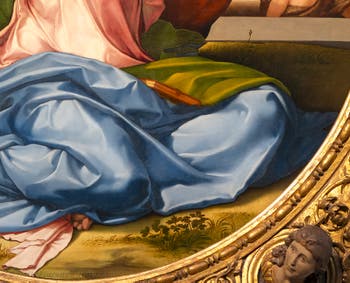Uffizi Artists | Location | Opening Hours Tickets | Authorizations
Artists Botticelli | Michelangelo | Da Vinci | Caravaggio | Raphael | Titian | Giorgione | Medici | Dürer Cranach Memling | Credi Bartolomeo | Rubens
The “Holy Family” in Michelangelo's Tondo Doni: Unity and light
The proximity of these two beings creates an effect of unwavering unity: they seem to belong to the same substance, like two statues carved from a single block of marble, with pleats and well-marked contour lines.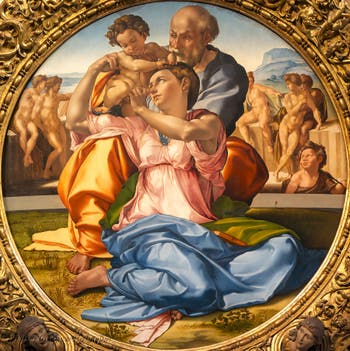
The Holy Family This profound unity, coupled with an effect of relief, gives strength and reality to the Incarnation thanks to this beautiful image of Mary, who lovingly welcomes the eternal Word who came voluntarily from the Father to become man in her body, placed at the centre of Tondo Doni.
Tondo Doni is undoubtedly focused on the luminous body and the face of Mary: her pink dress changes to white, a symbol of purity, because a pure heart is needed to welcome Jesus Christ and receive light.
Through the rotational movement of her chest and head, Mary guides the viewer's gaze, looking up at Jesus.
A beautiful image of Mary the Immaculate Conception is responsible for guiding the human being to the light and his salvation.
Michelangelo The Holy Family, the “Tondo Doni”, is a Homage to Hellenic sculpture
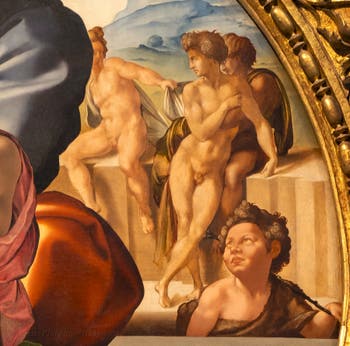
The Holy Family Jesus was born in Bethlehem because his parents had gone to be registered in their country of origin under Roman rule.
From this point of view, Michelangelo was not committing any anachronism by representing the Virgin Mary dressed in the antique style, sitting on heels following the style and elegance of the numerous statues of “Crouching Venus.”
Similarly, the face of the father appears in the severe and dignified features of an ancient sage, while Mary and Saint John the Baptist turn their heads towards Jesus at the same angle, like the statue of Alexander dying.
From April to November 1506, Michelangelo was in Florence, where he could rework and use his drawings made in Rome based on ancient models, such as the sketch of the head of Alexander Dying exhibited at the Casa Buonarroti.
Michelangelo and the Greek beauty ideal
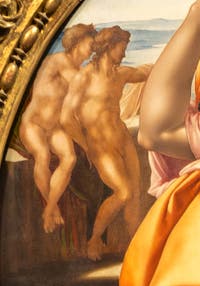
The Holy Family The five male nudes in the background represent the beauty ideal of the ancient Greeks.
Their harmonious muscles and attitudes are very similar to those of the ancient statues discovered amidst Roman ruins during the work undertaken during the Renaissance period.
Starting with the two on the left, the first is sitting, and the other is leaning against the wall.
The first has his legs crossed at the ankles, his chest and head turned to the right, like the Apollo sitting, except his arms are hidden by his neighbour.
He is standing, with his right hand hidden behind his buttocks, leaning against the wall, looking to the right, raising his left arm, half of which is hidden by Mary's arm; apart from the inverted position of his legs, his attitude evokes that of Apollo of Belvedere (with his forearm and his hand, amputated).
Michelangelo and the Laocoon Statue
As for those on the right, whoever draws the sheet sharply while looking at the other two finds himself in a position almost identical to that of the statue of “Laocoon and his sons” discovered in Rome in January 1506.
Laocoön and his Sons Michelangelo was one of the first to see this statue of Laocoon, whose right arm was missing.
He even sculpted the missing arm, adapted to the statue, until the original was recovered several hundred years later.
The man pulling the sheet seems angry at a couple of young men who turn their heads towards him; one of them is standing, resting on one leg, his chest lose, very relaxed, with one arm folded over that of his partner and the other arm softly pressed on the back of his hand... an attitude of abandonment almost identical to that of the funeral Eros, who has his head slightly tilted and turned in the other direction.
These naked men are sitting along an arched wall.
In presenting them on the curvature of this wall, Michelangelo followed a curved perspective that gives depth to his circular painting and volume to his characters.
This relief effect is already underlined by the grey line of the first wall that passes in front of Saint John the Baptist, which gives this phenomenal presence to the characters of the Holy Family.
Michelangelo's Tondo Doni at the Uffizzi: Fierce Love, Friendship, Divine Love
The different characters in the Tondo Doni Holy Family have one thing in common: everyone is looking at someone.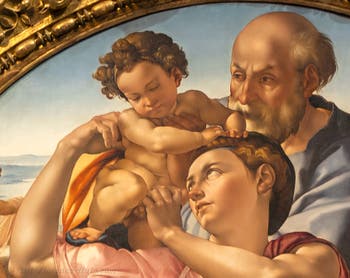
The Holy Family The father looks at the Child Jesus, himself contemplated by Mary and Saint John the Baptist, who look up at him, while the five men sitting in the background look at each other.
The eye is always drawn to the beauty of what surrounds us. Beauty calls for love.
According to Plato, sight arouses desire.
The sight of a beautiful body arouses the desire for that body.
But, through dialogue with others and personal reflection, this attraction is transformed into a love for the ideal beauty of the human body.
It rises by degrees to a love for the beautiful things of the spirit, to finally know the pure love of Universal Beauty.
Michelangelo and Platonic philosophy
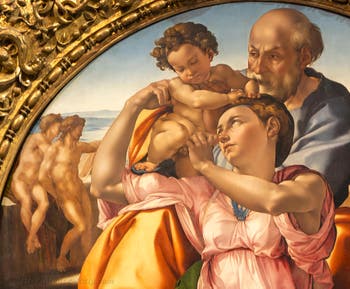
The Holy Family Platonic philosophy was known to the Florentines thanks to Marsile Ficin, a humanist priest who founded the Neoplatonist Circle in Florence and the author of a “Commentary on Plato's Banquet.”
Michelangelo spent time with Marsilius Ficin during his stay at the palace of Laurent de Medici during the years 1490-92.
Ficin also said that love begins with the sight of an attractive body and that everything depends on the lover's reactions and choices, leading him to three different types of life.
The Holy Family of Tondo Doni by Michelangelo: Three ways of loving
The characters in Michelangelo's Tondo Doni present these three ways of loving:1. - Ferocious Love
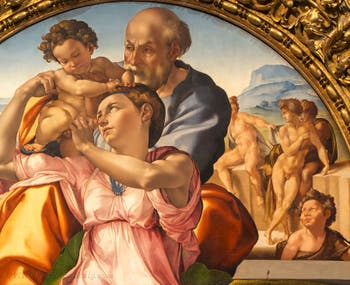
The Holy Family We move towards a voluptuous life when visual pleasure is reduced to physical desire and is limited to the search for pleasure and tactile pleasure, which Ficin called “ferocious love,” illustrated by naked men.
2. - Human Love
We move towards a balanced, active life when visual pleasure is accompanied by the pleasure of the mind aroused by the moral and intellectual qualities of the person we love.As a result, the attraction will change to admiration and give way to friendship, which Ficin called “human love,” illustrated by Saint John the Baptist, located equidistant between naked men and the Holy Family.
3. - Divine Love
We turn towards a purely spiritual life if visual pleasure rises towards contemplation and love of the divine form alone, which Ficin calls “divine love”, illustrated by this perfect model of the contemplative life: the tender gaze of Mary, ready to welcome the Child in whom God has revealed himself.The Virgin Mary in Michelangelo's “Holy Family”: Symbol of humanity's ardent desire
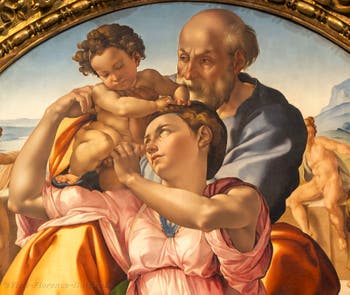
The Holy Family Mary is the symbol of humanity's ardent desire for its Creator, the desire to see God, and the ancestral need for transcendence well known to ancient philosophers.
Mary is the model of pure spiritual life for everyone, regardless of gender.
Marie's androgyny and the athletic physique of the Tondo Doni figures are, therefore, not due to a simple fantasy of an artist fascinated by masculine aesthetics.
Michelangelo had invented a new style, a new ideal represented by these powerful bodies that he would later impose by painting his magnificent frescoes in the Sistine Chapel.
The body and sin in Michelangelo's painting of the Holy Family
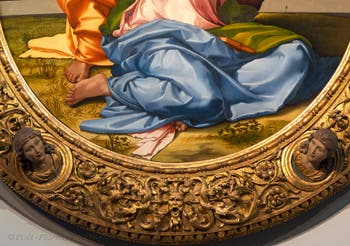
The Holy Family There is no shortage of references to the body, sin, and salvation in Michelangelo's well-known sacred texts.
And if there is one that fits well with Tondo Doni, it's Saint Paul's Epistle to the Ephesians:
“And you who were dead by your mistakes and your sins, where in the past you lived according to the course of this world. [...]
We too were all of them when we once behaved according to the desires of our flesh, doing the will of the flesh and of our thoughts, and we were naturally doomed to anger, just like the others.”
The Pleiade New Testament (N.T.) - Saint Paul Epistle to the Ephesians 2, 1-3
“... remember (you uncircumcised people) that at that time you were without Christ, without authority in Israel, strangers to the covenants of the Promise, without hope, and without God in the world.
The Holy Family But now, in Christ Jesus, you who once were FAR AWAY have become CLOSE through the blood of Christ.
For it is he who is our PEACE, he who of the two worlds made one and destroyed the wall that separated them: hate. [...]
So then you are no longer strangers or sojourners, but you are fellow citizens of the Saints, you are of the house of God, built on the foundation of the apostles and prophets with Christ Jesus himself as the cornerstone.”
The Pleiade New Testament (N.T.) - Saint Paul Epistle to the Ephesians 2, 12-15, and 19-21
Thus, following Mary's example, everyone is called to be part of the community of the Holy Spirit, to become a stone in the construction of the sacred edifice.
Such is the richness and novelty of this image of Tondo Doni full of strength and optimism: it is a creation born of the encounter of Renaissance humanism with the ancient Faith in the Man-God, from the encounter of Neo-Platonic thought with Faith in Jesus Christ born of a woman called Mary.
Natural and supernatural of Michelangelo's Holy Family
Artists Botticelli | Michelangelo | Da Vinci | Caravaggio | Raphael | Titian | Giorgione | Medici | Dürer Cranach Memling | Credi Bartolomeo | Rubens
Uffizi Artists | Location | Opening Hours Tickets | Authorizations
Back to Top of Page


